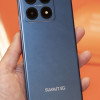Review: HTC HD2
The HTC HD2 uses the HTC Sense UI concept. This is distinct from the HTC Sense interface on Android devices. Some of the icons and design language are the same, but otherwise it's completely different. The interface goes to great lengths to hide the Windows Mobile underpinnings, perhaps more than on any other phone I've seen, and this is a good thing for this generation of Windows Mobile. The only remnant you'll find is pressing the Windows button at the bottom of the screen, which brings up the honeycomb-style application list found on other WinMo phones. Otherwise, even the archaic settings menus have been replaced with a more friendly HTC design.
The main structure uses a tabbed bar at the bottom, and you can slide your finger or tap directly on the choice you want. This main screen gives you access to some of the phone's key features, including the Web browser, e-mail and text messaging, contacts and calendar, even Twitter. I would have liked to find a navigation tab, for instance, and though you can choose to customize your tabs from a limited selection, you can also add application shortcuts to the main Home screen.
While the first HTC Sense phones were sluggish and unresponsive, the HTC HD2, with its fast, 1GHz Snapdragon processor, had no trouble chewing through the polished and modern looking interface. Animations were smooth, and there was no delay in the touch response. My only complaint is that I couldn't easily organize the App menu, and I couldn't customize the tabbed menu screens to my liking. The App menu, part of the standard WinMo kit, is tedious to rearrange. For the tabs, there are no widgets, no way to rearrange or customize items on the tabs beyond HTC's own structure.







 Hands On with the TCL Stylus 5G
Hands On with the TCL Stylus 5G
 Samsung Refines its Foldable Phones
Samsung Refines its Foldable Phones
 iPhone 14 Plus Offers a Big Screen For Less
iPhone 14 Plus Offers a Big Screen For Less
 Snapdragon 8 Gen 2 Redefines AI in Flagship Phones
Snapdragon 8 Gen 2 Redefines AI in Flagship Phones
 Hands On with the Boost Summit 5G
Hands On with the Boost Summit 5G








